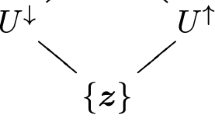Abstract
On the basis of four physically motivated assumptions, it is shown that a general quantum measurement of commuting observables can be represented by a “local transition map,” a special type of positive linear map on a von Neumann algebra. In the case that the algebra is the bounded operators on a Hilbert space, these local transition maps share two properties of von Neumann-type measurements: they decrease “matrix elements” of states and increase their entropy. It is also shown that local transition maps have all the properties of a conditional expectation of a von Neumann algebra onto a subalgebra except that their range is not restricted to the subalgebra. The notion of locality arises from requiring that a quantum measurement may be treated classically when restricted to the commutative algebra generated by the measured observables. The formalism established applies to observables with arbitrary spectrum. In the case that the spectrum is continuous we have only “incomplete” measurements.
Similar content being viewed by others
References
Neumann, J. Von: Mathematical foundations of quantum mechanics. Princeton: Princeton University Press 1955
Wehrl, A.: Rev. Mod. Phys.50, 221–260 (1978)
Lindblad, G.: Commun. Math. Phys.28, 245–249 (1972)
Nakamura, M., Umegaki, H.: Math. Jpn.7, 151–157 (1962)
Davies, E. B., Lewis, J. T.: Commun. Math. Phys.17, 239–260 (1970)
Davies, E. B.: Quantum theory of open systems. New York: Academic Press 1976
Gudder, S.: Stochastic methods in quantum mechanics. New York: North Holland 1979
Srinivas, M.: Commun. Math. Phys.71, 131–158 (1980)
Umegaki, H.: Tohoku Math. J.6, 177–181 (1954)
Nakamura, M., Turumaru, T.: Tohoku Math. J.6, 182–188 (1954)
Sakai, S.:C*-Algebras andW*-Algebras. Berlin, Heidelberg, New York: Springer 1971
Tomiyama, J.: Proc. Jpn. Acad.33, 608–612 (1957)
Stormer, E.: Math. Scand.30, 46–50 (1972)
Takesaki, M.: Theory of operator algebras 1. Berlin, Heidelberg, New York: Springer 1979
Lindblad, G.: Commun. Math. Phys.48, 119–130 (1976)
Stinespring, W. F.: Proc. Am. Math. Soc.6, 211–216 (1955)
Reed, M., Simon, B.: Methods of modern mathematical physics, Vol. 1: Functional Analysis, New York: Academic Press 1972
Mercer, R.: Operator-Valued kernels. (To be published)
Halmos, P., Sunder, V. S.: Bounded integral operators onL 2 spaces. Berlin, Heidelberg, New York: Springer 1978
Lindblad, G.: Commun. Math. Phys.33, 305–322 (1973)
Kelley, J., Namioka, I.: Linear topological spaces. Princeton: Van Nostrand 1963
Evans, D. E., Lewis, J. T.: Dilations of irreversible evolutions in algebric quantum theory. Dublin Institute for Advanced Studies (1977)
Author information
Authors and Affiliations
Additional information
Communicated by R. Haag
Rights and permissions
About this article
Cite this article
Mercer, R. General quantum measurements: Local transition maps. Commun.Math. Phys. 84, 239–250 (1982). https://doi.org/10.1007/BF01208570
Received:
Revised:
Issue Date:
DOI: https://doi.org/10.1007/BF01208570




